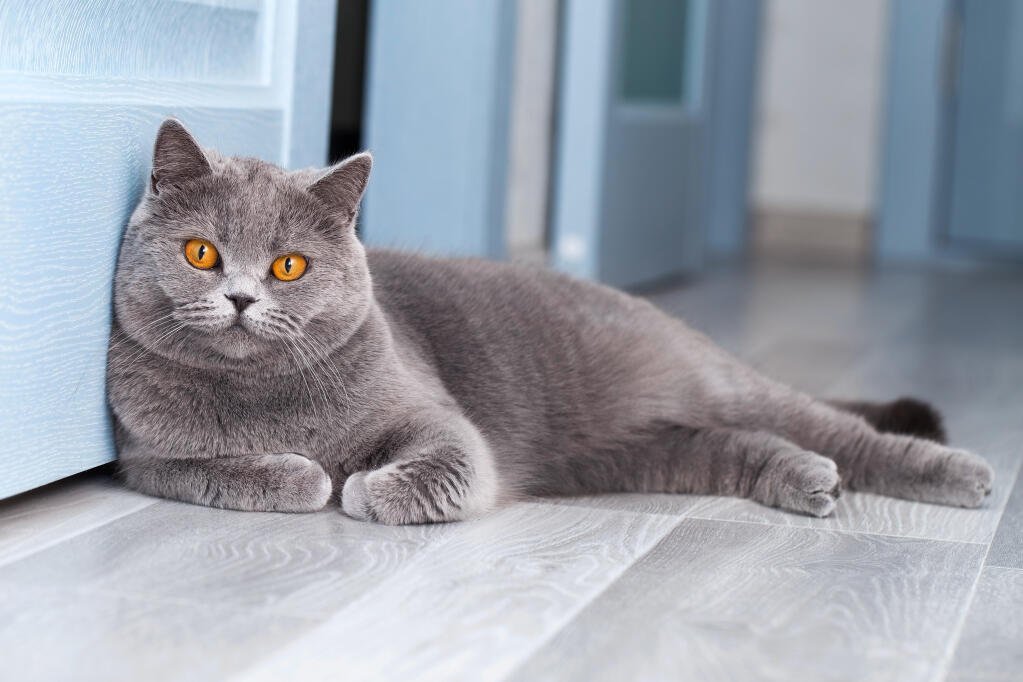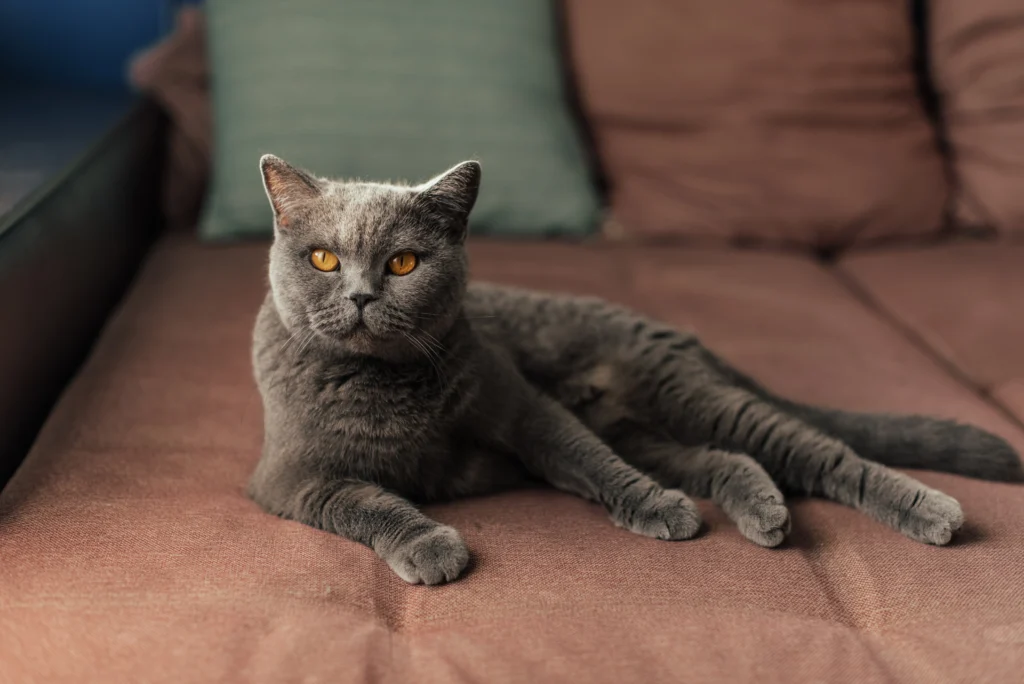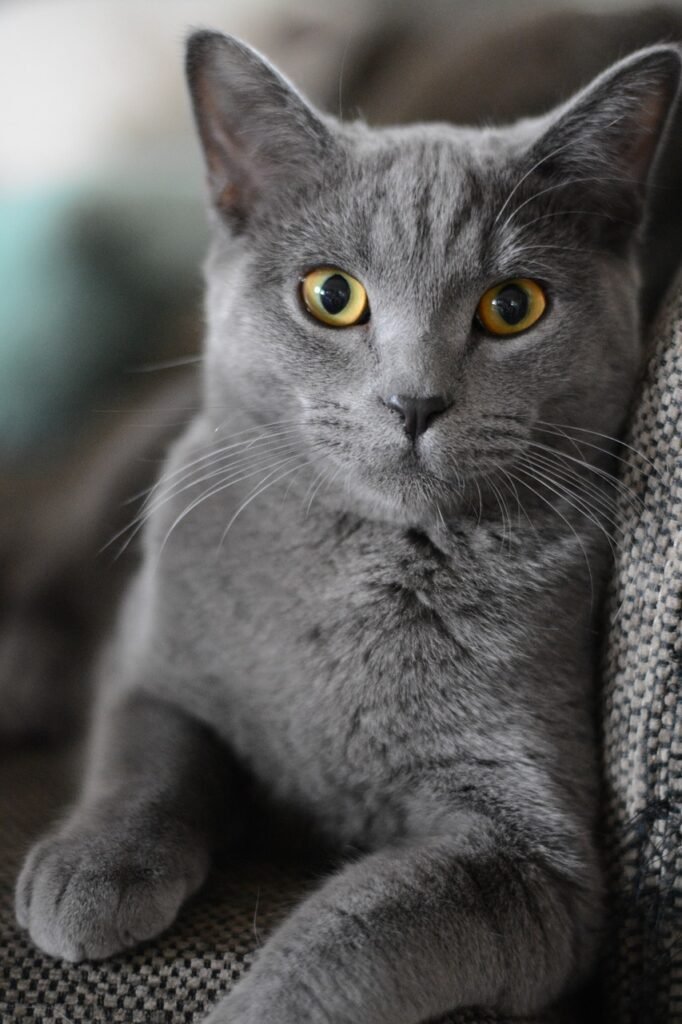British Shorthair
The British Shorthair cat is a breed known for its distinct physical attributes and charming personality, making it one of the most beloved cat breeds in the world. Characterized by a robust and muscular build, this breed exudes a sense of strength and stability. The British Shorthair’s dense coat, which is often compared to that of a teddy bear, adds to its unique appeal. This plush fur comes in a wide array of colors and patterns including the classic blue, which is perhaps the most recognized among enthusiasts. Other color variations include cream, black, silver, and various tabby patterns, showcasing the breed’s versatility.

One striking feature of the British Shorthair is its round face, complete with a short nose and full cheeks that lend it a distinctively endearing expression. The large, round eyes of this breed can be copper, gold, or blue, depending on the color of the coat, further enhancing its charming appearance. Their sturdy legs and large, rounded paws contribute to their overall robust look, making them easily distinguishable from other breeds.
The history of the British Shorthair dates back to ancient times, as it is one of the oldest domestic cat breeds. Initially utilized for rodent control, the breed has evolved into a cherished companion animal throughout the United Kingdom and beyond. Its popularity has grown significantly since it was first showcased in cat shows during the late 19th century, cementing its status as a favorite among cat fanciers. The British Shorthair’s amiable temperament, coupled with its striking physical characteristics, continues to endear it to households around the world.

Personality
The British Shorthair cat is renowned for its distinctive personality traits, which make it a beloved companion for many families. One of the most notable characteristics of this breed is its calm demeanor. British Shorthairs are generally easygoing and do not exhibit the anxious tendencies that some other breeds might display. Their serene nature allows them to adapt well to various living environments, whether it be a bustling household with children or a quiet apartment setting.
Affectionate yet independent, British Shorthairs strike a harmonious balance in their relationships with humans. They tend to show love and companionship without being overly clingy, unlike some other breeds that require constant attention. This breed enjoys spending time with its owners but also values its alone time, allowing it to thrive in homes where the occupants have varied schedules. Their independent spirit does not manifest as aloofness; instead, it showcases their ability to engage at different levels based on their owner’s availability.
Socialization plays a crucial role in shaping the British Shorthair’s temperament. When properly introduced to new environments, people, and fellow pets, they typically handle change with ease. Their adaptable nature allows them to fit into various social situations without displaying signs of stress. In summary, the British Shorthair is characterized by a blend of calmness, affection, independence, and playfulness, making them a well-rounded and appealing addition to any household.
Origins
The British Shorthair cat is one of the oldest and most beloved domestic cat breeds, with a history that intertwines with that of the British Isles. Its origins can be traced back to ancient times, around the early days of the Roman invasion, when cats were brought to Britain to control the rodent population. These early felines played a crucial role in agriculture, maintaining the health of stored food by eliminating pests. Over the centuries, these cats adapted to the British climate and environment, gradually establishing themselves as a distinct breed.

The British Shorthair’s physical traits, including its round face, stocky build, and dense coat, were honed through selective breeding. This process gained momentum in the late 19th century when cat shows became increasingly popular in Britain. During this period, breeders sought to enhance the breed’s distinctive characteristics, leading to the recognition of the British Shorthair as a formal breed. It was at this time that the breed was first showcased at cat exhibitions, which contributed significantly to its popularity.
In addition to their aesthetic qualities, British Shorthairs have been cherished in British culture, often associated with comfort and companionship. Their sturdy physique and amiable temperament made them family favorites. Furthermore, their association with the British Isles not only contributes to their name but also emphasizes their significance within British society. As history progressed, the British Shorthair became a symbol of British feline heritage, admired for its ability to adapt to various environments while maintaining a strong, affectionate bond with humans.
Understanding the historical context of the British Shorthair provides insight into its enduring popularity today. This breed, with its charming personality and robust nature, continues to capture the hearts of cat enthusiasts around the world, solidifying its status as one of the most revered cat breeds in existence.
Care of the British Shorthair
Caring for a British Shorthair cat involves a holistic approach that encompasses nutrition, grooming, veterinary care, and mental stimulation. Proper nutrition is paramount for maintaining the health of these robust felines. A balanced diet formulated for their age, weight, and activity level is crucial. High-quality commercial cat food, ideally composed of meat as the primary ingredient, can help ensure they receive the necessary nutrients. It is also advisable to consult a veterinarian for personalized feeding guidelines, as the British Shorthair may be prone to obesity if overfed.
The grooming needs of British Shorthair cats are significant due to their dense, plush coat. While their short hair requires less maintenance than long-haired breeds, they still benefit from regular brushing to prevent matting and reduce shedding. Grooming sessions can also serve as bonding activities between the cat and its owner. Weekly brushing, combined with occasional bathing, can keep their coat healthy and shiny. Regular checking of their ears, teeth, and claws is also essential to ensure overall well-being.
Routine veterinary check-ups are an important aspect of caring for a British Shorthair. These annual or biannual visits allow for vaccinations, dental assessments, and general health evaluations. Early detection of potential health issues like hypertrophic cardiomyopathy, a common condition in the breed, can significantly improve treatment outcomes.
Furthermore, British Shorthairs thrive on mental stimulation and exercise. Interactive toys, climbing structures, and scheduled playtime are essential for keeping them engaged and active. This breed’s affectionate nature makes it well-suited for families or individuals, thriving in various environments, including apartments and homes. Addressing their physical and psychological needs ensures that they remain healthy and happy companions.
Health
The British Shorthair is a sturdy and healthy cat breed, but like all felines, they have specific health considerations. Regular vet check-ups, a balanced diet, and proper exercise help maintain their well-being. Common health concerns include obesity, hypertrophic cardiomyopathy (HCM), and polycystic kidney disease (PKD). Preventive care, high-quality nutrition, and routine screenings are essential for a long, healthy life.
Nutrition
Proper nutrition is essential to keep your British Shorthair healthy, strong, and active. This breed requires a high-protein diet with balanced fats and essential nutrients to support its muscular build and thick coat. Opt for high-quality cat food rich in animal proteins like chicken or fish, and avoid fillers like corn or wheat that provide little nutritional value.
Since British Shorthairs are prone to obesity, portion control and regular feeding schedules are key. Including omega-3 fatty acids, taurine, and fiber in their diet helps maintain heart health, digestion, and a shiny coat. Fresh water should always be available to support hydration.
Cleanliness
The British Shorthair is known for its excellent cleanliness and low-maintenance grooming needs. Thanks to its dense, plush coat, this breed rarely gets tangled or matted, requiring only weekly brushing to remove loose hairs and maintain its soft texture. Unlike long-haired breeds, British Shorthairs are meticulous self-groomers, keeping themselves naturally clean.
To ensure optimal hygiene, regular care such as ear cleaning, nail trimming, and dental maintenance is recommended. Their calm nature makes grooming a stress-free experience, making them an ideal pet for owners seeking a clean and well-groomed companion.
Best cat breeds for kids
The British Shorthair is one of the best cat breeds for kids, thanks to its calm, affectionate, and patient nature. This sturdy and low-maintenance breed is known for its plush coat, round face, and gentle temperament, making it a great companion for children.
Unlike more energetic breeds, the British Shorthair enjoys playtime but is also content with relaxing alongside family members. Their adaptability and friendly personality make them ideal for households with young kids. Plus, they require minimal grooming, making pet care easy for busy families.
People who have seen this breed have also visited…
In this section you can find completely detailed information about the breed of your cat.
